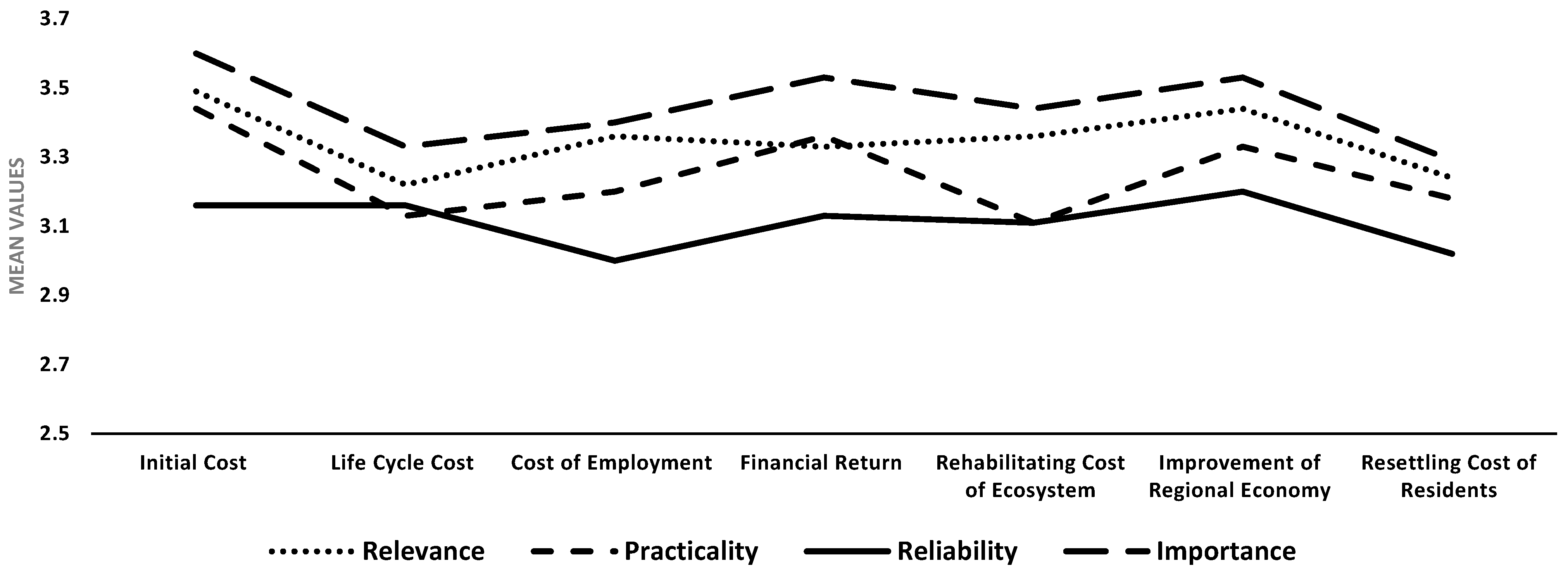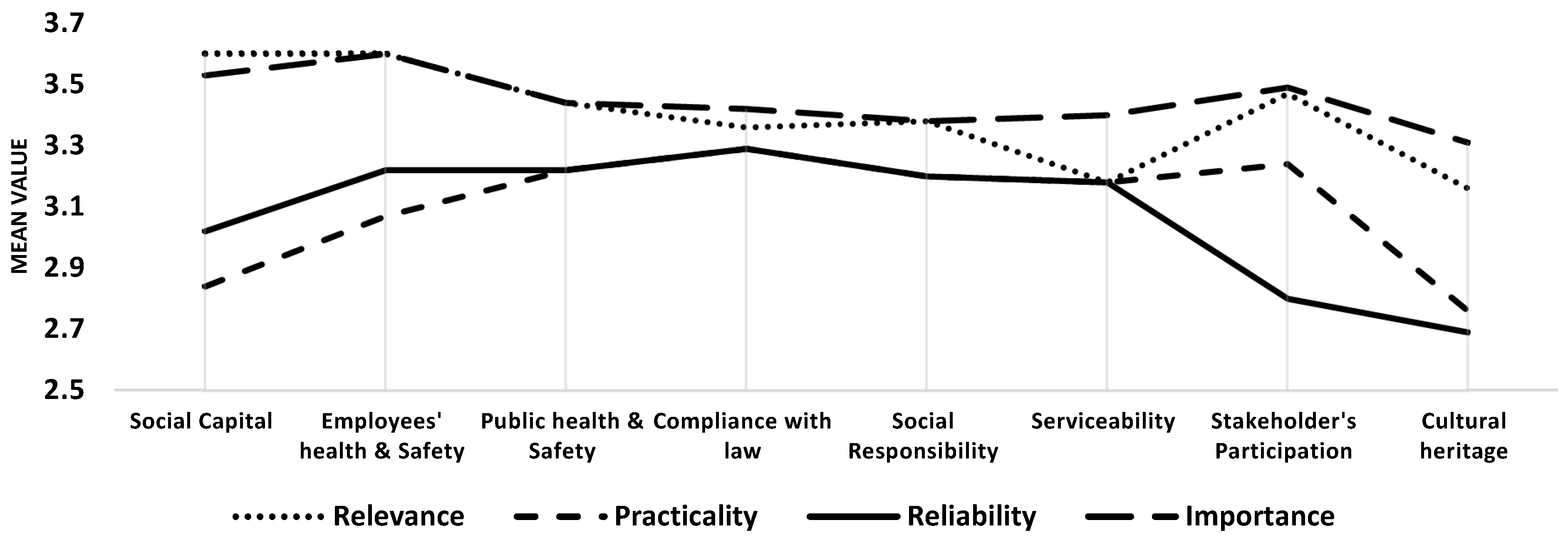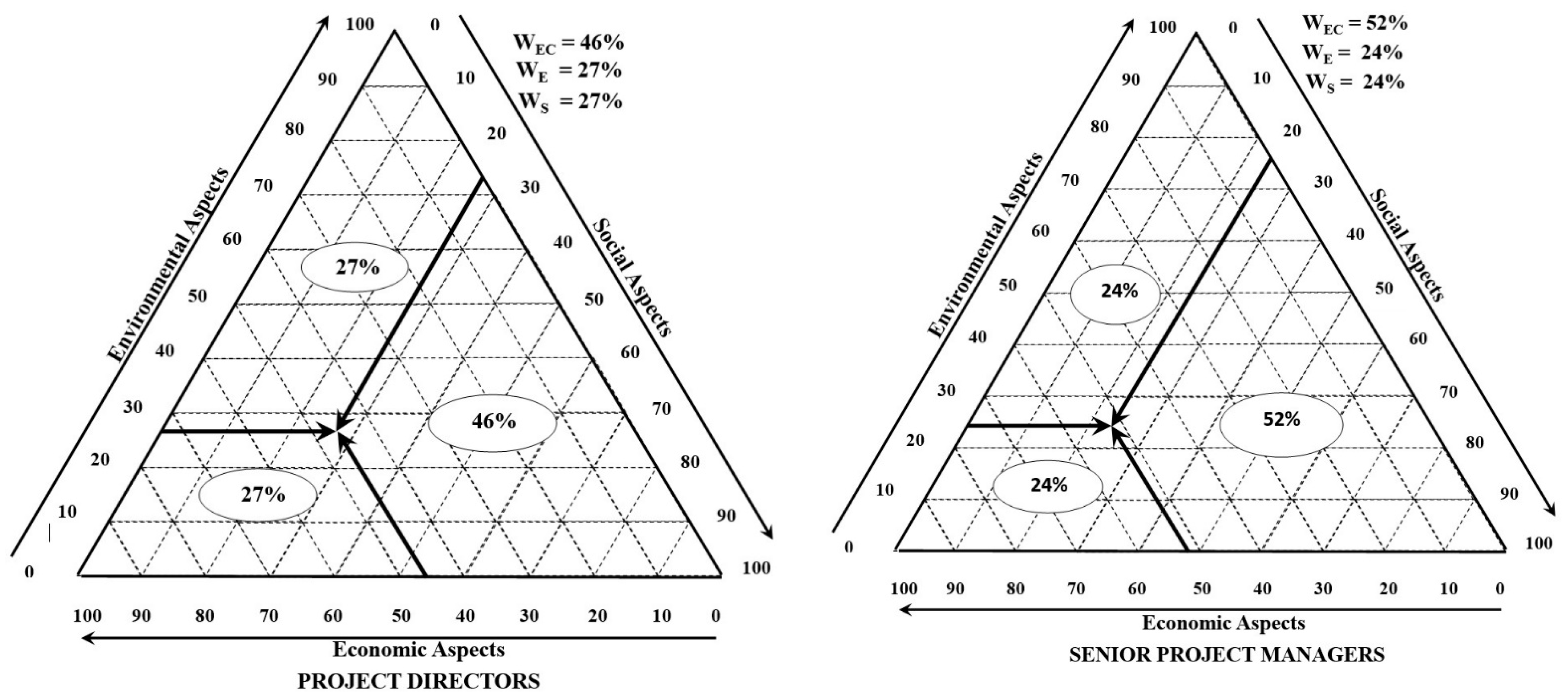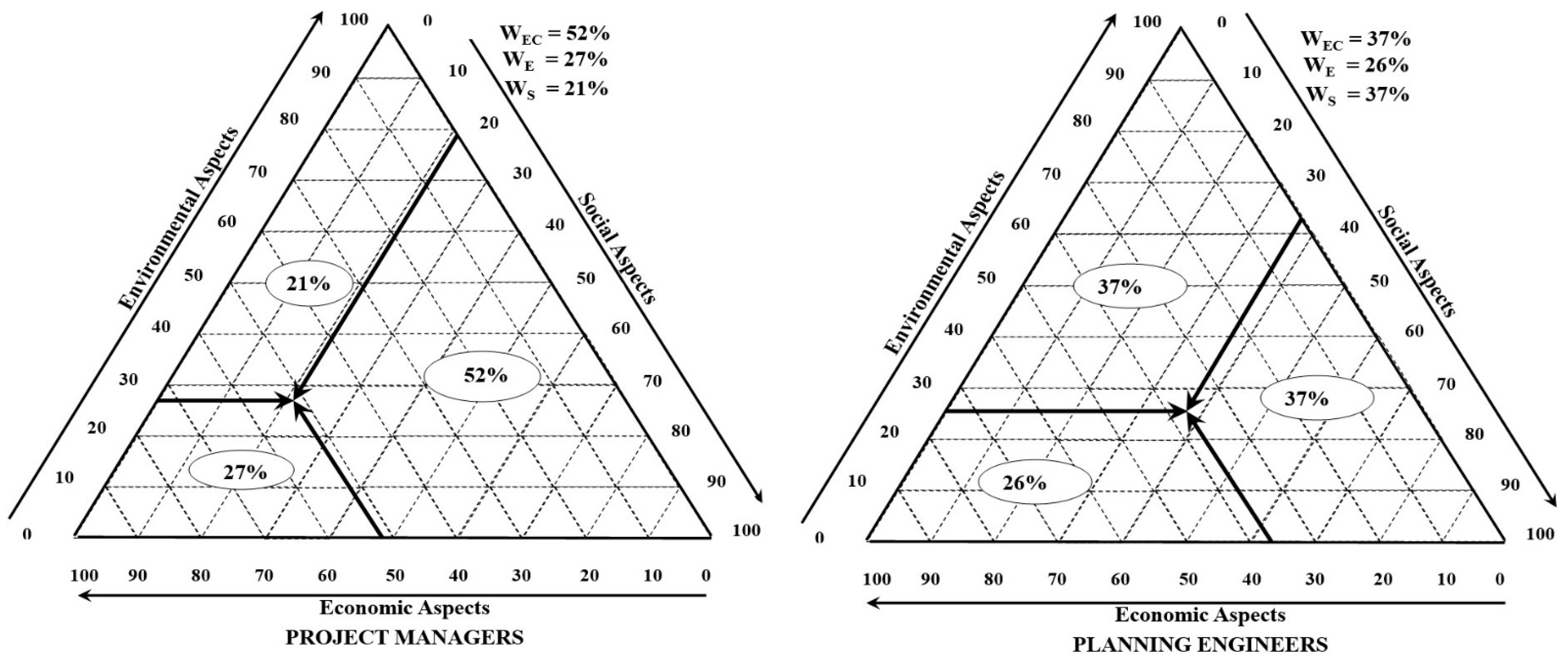Most Relevant Sustainability Criteria for Urban Infrastructure Projects—AHP Analysis for the Gulf States
Abstract
:1. Introduction
2. Materials and Methods
Questionnaire Design and Selection of Indicators
3. Results
Analytical Hierarchy Process Analysis
4. Discussion
Analysis of the Sustainability Dimensions
- WEC Weight of Economic Aspect
- WE Weight of Environmental Aspect
- WS Weight of Social Aspect
- WE + WEC + WS = 100%
5. Conclusions
Supplementary Materials
Author Contributions
Funding
Institutional Review Board Statement
Informed Consent Statement
Data Availability Statement
Conflicts of Interest
References
- Wang, J.; Cao, S.J.; Yu, C.W. Development trends and challenges of sustainable urban design in the digital age. Indoor Built Environ. 2021, 30, 3–6. [Google Scholar] [CrossRef]
- European Environmental Agency. Urban Sustainability Issues—What Is a Resource-Efficient City? EEA Technical Report No 23/2015; Publications Office of the European Union: Luxembourg, 2015. [CrossRef]
- Habitat, U.N. World Cities Report 2016: Urbanization and Development: Emerging Futures; United Nations Human Settlements Programme: Nairobi, Kenya, 2016. [Google Scholar]
- Ioppolo, G.; Heijungs, R.; Cucurachi, S.; Salomone, R.; Kleijn, R. Urban Metabolism: Many Open questions for future answers. In Pathways to Environmental Sustainability; Springer International Publishing: Cham, Switzerland, 2014; pp. 23–32. [Google Scholar] [CrossRef]
- Chen, S.; Chen, B.; Feng, K.; Liu, Z.; Fromer, N.; Tan, X.; Alsaedi, A.; Hayat, T.; Weisz, H.; Hubacek, K. Physical and virtual carbon metabolism of global cities. Nat. Commun. 2020, 11, 182. [Google Scholar] [CrossRef] [PubMed] [Green Version]
- Brundtland, G.H. World Commission on Environment and Development; Our Common Future: Oxford, UK, 1987. [Google Scholar]
- Kline, E. Sustainable Community Indicators; Draft Summarizing a Project Developing Sustainable Community; Tufts University: Medford, MA, USA, 1993. [Google Scholar]
- Ying, J.; Zhang, X.; Zhang, Y.; Bilan, S. Green infrastructure: Systematic literature review. Econ. Res.-Ekon. Istraživanja 2022, 35, 343–366. [Google Scholar] [CrossRef]
- Vilathgamuwa, M.; Mishra, Y.; Yigitcanlar, T.; Bhaskar, A.; Wilson, C. Mobile-energy-as-a-service (MEaaS): Sustainable electromobility via integrated energy-transport-urban infrastructure. Sustainability 2022, 14, 2796. [Google Scholar] [CrossRef]
- Benites, A.J.; Simoes, A.F. Assessing the urban sustainable development strategy: An application of a smart city services sustainability taxonomy. Ecol. Indic. 2021, 127, 107734. [Google Scholar] [CrossRef]
- Yang, J.; Yuan, M.; Yigitcanlar, T.; Newman, P.; Schultmann, F. Managing knowledge to promote sustainability in Australian transport infrastructure projects. Sustainability 2015, 7, 8132–8150. [Google Scholar] [CrossRef] [Green Version]
- Yigitcanlar, T. Sustainable Urban and REGIONAL Infrastructure Development: Technologies, Applications and Management; IGI Global: Hersey, PA, USA, 2010. [Google Scholar]
- Purvis, B.; Mao, Y.; Robinson, D. Three pillars of sustainability: In search of conceptual origins. Sustain. Sci. 2019, 14, 681–695. [Google Scholar] [CrossRef] [Green Version]
- Hendricks, M.D.; Meyer, M.A.; Gharaibeh, N.G.; Van Zandt, S.; Masterson, J.; Cooper, J.T., Jr.; Horney, J.A.; Berke, P. The development of a participatory assessment technique for infrastructure: Neighborhood-level monitoring towards sustainable infrastructure systems. Sustain. Cities Soc. 2018, 38, 265–274. [Google Scholar] [CrossRef]
- Sharifi, A. Urban sustainability assessment: An overview and bibliometric analysis. Ecol. Indic. 2021, 121, 107102. [Google Scholar] [CrossRef]
- Alqahtany, A.; Aravindakshan, S. Urbanization in Saudi Arabia and sustainability challenges of cities and heritage sites: Heuristical insights. J. Cult. Herit. Manag. Sustain. Dev. 2021. ahead-of-print. [Google Scholar] [CrossRef]
- Samad, W.A.; Azar, E. Smart Cities in the Gulf: An Overview; Samad, W., Azar, E., Eds.; Palgrave Macmillan: London, UK, 2019. [Google Scholar] [CrossRef]
- Anisurrahman, M.; Alshuwaikhat, H.M. Determining sustainability assessment indicators for the Holy City of Makkah, Saudi Arabia. Arab. J. Sci. Eng. 2019, 44, 5165–5178. [Google Scholar] [CrossRef]
- Alyami, S.H.; Rezgui, Y.; Kwan, A. Developing sustainable building assessment scheme for Saudi Arabia: Delphi consultation approach. Renew. Sustain. Energy Rev. 2013, 27, 43–54. [Google Scholar] [CrossRef]
- Dembińska, I. Infrastruktura Logistyczna Gospodarki w Ujęciu Środowiskowych Uwarunkowań Zrównoważonego Rozwoju; Wydawnictwo Naukowe Uniwersytetu Szczecińskiego: Szczecin, Poland, 2018; pp. 367–389. [Google Scholar]
- Wang, J.; Ren, Y.; Shu, T.; Shen, L.; Liao, X.; Yang, N.; He, H. Economic perspective-based analysis on urban infrastructures carrying capacity—A China study. Environ. Impact Assess. Rev. 2020, 83, 106381. [Google Scholar] [CrossRef]
- United Nations. Managing Infrastructure Assets for Sustainable Development; A Handbook for Local and National Governments. 2021. Available online: https://www.un.org/development/desa/financing/sites/www.un.org.development.desa.financing/files/2021-02/IAMH_2021_0.pdf (accessed on 27 September 2022).
- Stanitsas, M.; Kirytopoulos, K.; Leopoulos, V. Integrating sustainability indicators into project management: The case of the construction industry. J. Clean. Prod. 2021, 279, 123774. [Google Scholar] [CrossRef]
- Raiden, A.; King, A. Social value, organizational learning, and sustainable development goals in the built environment. Resour. Conserv. Recycl. 2021, 172, 105663. [Google Scholar] [CrossRef]
- Fatourehchi, D.; Zarghami, E. Social sustainability assessment framework for managing sustainable construction in residential buildings. J. Build. Eng. 2020, 32, 101761. [Google Scholar] [CrossRef]
- Zheng, X.; Easa, S.M.; Ji, T.; Jiang, Z. Incorporating uncertainty into life-cycle sustainability assessment of pavement alternatives. J. Clean. Prod. 2020, 264, 121466. [Google Scholar] [CrossRef]
- Burciaga, U.M. Sustainability assessment in housing building organizations for the design of strategies against climate change. High-Tech Innov. J. 2020, 1, 136–147. [Google Scholar] [CrossRef]
- Akhanova, G.; Nadeem, A.; Kim, J.R.; Azhar, S. A multi-criteria decision-making framework for building sustainability assessment in Kazakhstan. Sustain. Cities Soc. 2020, 52, 101842. [Google Scholar] [CrossRef]
- Coenen, T.B.; Haanstra, W.; Braaksma, A.J.; Santos, J. CEIMA: A framework for identifying critical interfaces between the Circular Economy and stakeholders in the lifecycle of infrastructure assets. Resour. Conserv. Recycl. 2020, 155, 104552. [Google Scholar] [CrossRef]
- Saxena, P.; Stavropoulos, P.; Kechagias, J.; Salonitis, K. Sustainability assessment for manufacturing operations. Energies 2020, 13, 2730. [Google Scholar] [CrossRef]
- Ameen, R.F.M.; Mourshed, M. Urban sustainability assessment framework development: The ranking and weighting of sustainability indicators using analytic hierarchy process. Sustain. Cities Soc. 2019, 44, 356–366. [Google Scholar] [CrossRef]
- Hanumante, N.C.; Shastri, Y.; Hoadley, A. Assessment of circular economy for global sustainability using an integrated model. Resour. Conserv. Recycl. 2019, 151, 104460. [Google Scholar] [CrossRef]
- Haider, H.; Hewage, K.; Umer, A.; Ruparathna, R.; Chhipi-Shrestha, G.; Culver, K.; Holland, M.; Kay, J.; Sadiq, R. Sustainability assessment framework for small-sized urban neighborhoods: An application of fuzzy synthetic evaluation. Sustain. Cities Soc. 2018, 36, 21–32. [Google Scholar] [CrossRef]
- Dong, L.; Wang, Y.; Scipioni, A.; Park, H.S.; Ren, J. Recent progress on innovative urban infrastructures system towards sustainable resource management. Resour. Conserv. Recycl. 2018, 128, 355–359. [Google Scholar] [CrossRef]
- Bryce, J.; Brodie, S.; Parry, T.; Presti, D.L. A systematic assessment of road pavement sustainability through a review of rating tools. Resour. Conserv. Recycl. 2017, 120, 108–118. [Google Scholar] [CrossRef]
- Hossaini, R.; Chipperfield, M.; Montzka, S.; Rap, A.; Dhomse, S.; Feng, W. Efficiency of short-lived halogens at influencing climate through depletion of stratospheric ozone. Nat. Geosci. 2015, 8, 186–190. [Google Scholar] [CrossRef]
- Onat, N.C.; Kucukvar, M.; Tatari, O. Integrating triple bottom line input-output analysis into life cycle sustainability assessment framework: The case for US building. Int. J. Life Cycle Assess. 2014, 19, 1488–1505. [Google Scholar] [CrossRef]
- Aberilla, M.; Gallego-Schmid, A.; Stamford, L.; Azapagic, A. Environmental sustainability of cooking fuels in remote communities: Life cycle and local impacts. Sci. Total Environ. 2020, 713, 136445. [Google Scholar] [CrossRef]
- Taelman, E.; De Meester, S.; Schaubroeck, T.; Sakshaug, E.; Alvarenga, R.A.F.; Dewulf, J. Accounting for the occupation of the marine environment as a natural resource in life cycle assessment: An exergy based approach. Resour. Conserv. Recycl. 2014, 91, 1–10. [Google Scholar] [CrossRef]
- Maurya, S.P.; Singh, P.K.; Ohri, A.; Singh, R. Identification of indicators for sustainable urban water development planning. Ecol. Indic. 2020, 108, 105691. [Google Scholar] [CrossRef]
- Hély, V.; Antoni, J.P. Combining indicators for decision making in planning issues: A theoretical approach to perform sustainability assessment. Sustain. Cities Soc. 2019, 44, 844–854. [Google Scholar] [CrossRef]
- Opher, T.; Friedler, E.; Shapira, A. Comparative life cycle sustainability assessment of urban water reuse at various centralization scales. Int. J. Life Cycle Assess. 2019, 24, 1319–1332. [Google Scholar] [CrossRef]
- An, D.; Xi, B.; Ren, J.; Ren, X.; Zhang, W.; Wang, Y.; Dong, L. Multi-criteria sustainability assessment of urban sludge treatment technologies: Method and case study. Resour. Conserv. Recycl. 2018, 128, 546–554. [Google Scholar] [CrossRef]
- An, D.; Xi, B.; Ren, J.; Wang, Y.; Jia, X.; He, C.; Li, Z. Sustainability assessment of groundwater remediation technologies based on multi-criteria decision-making method. Resour. Conserv. Recycl. 2017, 119, 36–46. [Google Scholar] [CrossRef]
- Venkatesh, G.; Brattebø, H.; Sægrov, S.; Behzadian, K.; Kapelan, Z. Metabolism-modeling approaches to long-term sustainability assessment of urban water services. Urban Water J. 2017, 14, 11–22. [Google Scholar] [CrossRef]
- Phillis, Y.A.; Kouikoglou, V.S.; Verdugo, C. Urban sustainability assessment and ranking of cities. Comput. Environ. Urban Syst. 2017, 64, 254–265. [Google Scholar] [CrossRef]
- Sharifi, F.; Nygaard, A.; Stone, W.M.; Levin, I. Green gentrification or gentrified greening: Metropolitan Melbourne. Land Use Policy 2021, 108, 105577. [Google Scholar] [CrossRef]
- Kivilä, J.; Martinsuo, M.; Vuorinen, L. Sustainable project management through project control in infrastructure projects. Int. J. Proj. Manag. 2017, 35, 1167–1183. [Google Scholar] [CrossRef]
- Tupenaite, L.; Lill, I.; Geipele, I.; Naimaviciene, J. Ranking of sustainability indicators for assessment of the new housing development projects: Case of the Baltic States. Resources 2017, 6, 55. [Google Scholar] [CrossRef] [Green Version]
- Kylili, A.; Fokaides, P.A.; Jimenez, P.A.L. Key Performance Indicators (KPIs) approach in buildings renovation for the sustainability of the built environment: A review. Renew. Sustain. Energy Rev. 2016, 56, 906–915. [Google Scholar] [CrossRef]
- Zeng, S.X.; Ma, H.Y.; Lin, H.; Zeng, R.C.; Tam, V.W. Social responsibility of major infrastructure projects in China. Int. J. Proj. Manag. 2015, 33, 537–548. [Google Scholar] [CrossRef]
- Yuan, H. Key indicators for assessing the effectiveness of waste management in construction projects. Ecol. Indic. 2013, 24, 476–484. [Google Scholar] [CrossRef]
- ISO/TS 21929-1: 2011; Sustainability in Building Construction—Sustainability Indicators—Part 1: Framework for the Development of Indicators for Buildings. ISO: Geneva, Switzerland, 2011; pp. 1–24.
- Shen, L.; Wu, Y.; Zhang, X. Key assessment indicators for the sustainability of infrastructure projects. J. Constr. Eng. Manag. 2011, 137, 441–451. [Google Scholar] [CrossRef] [Green Version]
- Alsulami, B.; Mohamed, S. Key sustainability indicators for infrastructure systems: An Australian perspective. In Proceedings of the Sixth International Conference on Construction in the 21st Century (CITC-VI). Construction Challenges in the New Decade, Kuala Lumpur, Malaysia, 5–7 July 2011; pp. 1133–1140. [Google Scholar]
- Ugwu, O.O.; Haupt, T.C. Key performance indicators and assessment methods for infrastructure sustainability—A South African construction industry perspective. Build. Environ. 2007, 42, 665–680. [Google Scholar] [CrossRef]
- Antucheviciene, J.; Zakarevičius, A.; Zavadskas, E.K. Multiple criteria construction management decisions considering relations between measures. Technol. Econ. Dev. Econ. 2010, 16, 109–125. [Google Scholar] [CrossRef]
- Fernandez-Sánchez, G.; Rodríguez-López, F. A methodology to identify sustainability indicators in construction project management—Application to infrastructure projects in Spain. Ecol. Indic. 2010, 10, 1193–1201. [Google Scholar] [CrossRef]
- Saaty, T.L. Decision making with the analytic hierarchy process. Int. J. Serv. Sci. 2008, 1, 83–98. Available online: https://www.inderscienceonline.com/doi/abs/10.1504/IJSSci.2008.01759 (accessed on 27 September 2022). [CrossRef] [Green Version]
- Ransikarbum, K.; Khamhong, P. Integrated fuzzy analytic hierarchy process and technique for order of preference by similarity to ideal solution for additive manufacturing printer selection. J. Mater. Eng. Perform. 2021, 30, 6481–6492. [Google Scholar] [CrossRef]
- Ransikarbum, K.; Pitakaso, R.; Kim, N.; Ma, J. Multicriteria decision analysis framework for part orientation analysis in additive manufacturing. J. Comput. Des. Eng. 2021, 8, 1141–1157. [Google Scholar] [CrossRef]
- Gan, X.; Fernandez, I.C.; Guo, J.; Wilson, M.; Zhao, Y.; Zhou, B.; Wu, J. When to use what: Methods for weighting and aggregating sustainability indicators. Ecol. Indic. 2017, 81, 491–502. [Google Scholar] [CrossRef]
- Si, J.; Marjanovic-Halburd, L.; Nasiri, F.; Bell, S. Assessment of building-integrated green technologies: A review and case study on applications of Multi-Criteria Decision Making (MCDM) method. Sustain. Cities Soc. 2016, 27, 106–115. [Google Scholar] [CrossRef]
- Chanthakhot, W.; Ransikarbum, K. Integrated IEW-TOPSIS and fire dynamics simulation for agent-based evacuation modeling in industrial safety. Safety 2021, 7, 47. [Google Scholar] [CrossRef]
- Ransikarbum, K.; Pitakaso, R.; Kim, N. A decision-support model for additive manufacturing scheduling using an integrative analytic hierarchy process and multi-objective optimization. Appl. Sci. 2020, 10, 5159. [Google Scholar] [CrossRef]
- Işik, Z.; Aladağ, H. A fuzzy AHP model to assess sustainable performance of the construction industry from urban regeneration perspective. J. Civ. Eng. Manag. 2017, 23, 499–509. [Google Scholar] [CrossRef] [Green Version]
- Abdul-Rahman, H.; Wang, C.; Wood, L.C.; Ebrahimi, M. Integrating and ranking sustainability criteria for housing. Proc. Inst. Civ. Eng.-Eng. Sustain. 2015, 169, 3–30. [Google Scholar] [CrossRef] [Green Version]
- Yu, W.; Li, B.; Yang, X.; Wang, Q. Development of a rating method and weighting system for green store buildings in China. Renew. Energy 2015, 73, 123–129. [Google Scholar] [CrossRef]
- Nilashi, M.; Zakaria, R.; Ibrahim, O.; Majid, M.Z.A.; Zin, R.M.; Chugtai, M.W.; Abidin, N.I.Z.; Sahamir, S.R.; Yakubu, D.A. A knowledge-based expert system for assessing the performance level of green buildings. Knowl. Based Syst. 2015, 86, 194–209. [Google Scholar] [CrossRef]
- McHugh, M.L. Multiple comparison analysis testing in ANOVA. Biochem. Med. 2011, 21, 203–209. [Google Scholar] [CrossRef]
- Rogelj, J.; Den Elzen, M.; Höhne, N.; Fransen, T.; Fekete, H.; Winkler, H.; Meinshausen, M. Paris Agreement climate proposals need a boost to keep warming well below 2 C. Nature 2016, 534, 631–639. [Google Scholar] [CrossRef] [Green Version]
- Saaty, T.L.; Vargas, L.G. Models, Methods, Concepts & Applications of the Analytic Hierarchy Process; Springer Science & Business Media: New York, NY, USA, 2012. [Google Scholar] [CrossRef]
- Salo, A.A.; Hamalainen, R.P. On the measurement of preferences in the analytic hierarchy process. J. Multi-Criteria Decis. Anal. 1997, 6, 309–319. [Google Scholar] [CrossRef]
- Pöyhönen, M.; Hämäläinen, R.P. On the Convergence of Multiattribute Weighting Methods; Helsinki University of Technology: Helsinki, Finland, 1997; pp. 1–16. [Google Scholar]
- Harker, P.T.; Vargas, L.G. The theory of ratio scale estimation: Saaty’s analytic hierarchy process. Manag. Sci. 1987, 33, 1383–1403. [Google Scholar] [CrossRef]
- Saaty, T.L. The Analytic Hierarchy Process: Planning, Priority Setting, Resource Allocation; McGraw-Hill: New York, NY, USA, 1980. [Google Scholar]
- Sierra, L.A.; Yepes, V.; Pellicer, E. A review of multi-criteria assessment of the social sustainability of infrastructures. J. Clean. Prod. 2018, 187, 496–513. [Google Scholar] [CrossRef]
- Sierra, L.A.; Yepes, V.; Pellicer, E. Assessing the social sustainability contribution of an infrastructure project under conditions of uncertainty. Environ. Impact Assess. Rev. 2017, 67, 61–72. [Google Scholar] [CrossRef]
- Eizenberg, E.; Jabareen, Y. Social sustainability: A new conceptual framework. Sustainability 2017, 9, 68. [Google Scholar] [CrossRef] [Green Version]
- Hofstetter, P.; Braunschweig, A.; Mettier, T.; Müller-Wenk, R.; Tietje, O. The Mixing Triangle: Correlation and Graphical Decision Support for LCA-based Comparisons. J. Ind. Ecol. 1999, 3, 97–115. [Google Scholar] [CrossRef]
- Finkbeiner, M.; Schau, E.M.; Lehmann, A.; Traverso, M. Towards life cycle sustainability assessment. Sustainability 2010, 2, 3309–3322. [Google Scholar] [CrossRef]







| Questionnaire Part 1 | Division/ Range | No. of Respondents (163 Entries) | Respondents % (163 Entries) | No. of Respondents (125 Entries) | Respondents % (125 Entries) |
|---|---|---|---|---|---|
| Gender | Male | 123 | 75% | 97 | 78% |
| Female | 40 | 25% | 28 | 22% | |
| Age (in years) | 25–40 | 86 | 53% | 69 | 55% |
| 41–60 | 59 | 36% | 43 | 34% | |
| >60 | 18 | 11% | 13 | 11% | |
| Work experience (in years) | 0–5 | 40 | 25% | 28 | 22% |
| 6–10 | 58 | 36% | 45 | 36% | |
| >10 | 65 | 39% | 52 | 42% | |
| Qualification | Ph.D. | 17 | 10% | 08 | 7% |
| Master’s | 114 | 70% | 98 | 78% | |
| Bachelor’s | 23 | 14% | 14 | 11% | |
| Other | 9 | 6% | 5 | 4% |
| Respondents | Participation in Sustainability-Led Projects | Understanding of Sustainability Initiative | Exp. in Employing Sustainability Evaluation Tools | ||||
|---|---|---|---|---|---|---|---|
| Project Director | 26% | Yes: Participated in the Projects | (56%) | GRI (Global Reporting Initiative) | (72%) | Yes: Employed | (46%) |
| Senior Project Managers | 28% | No: Not Participated in the Project | (44%) | UNCSD (United Nations Commission for Sustainability Development) | (66%) | No: Not Employed | (54%) |
| Project Managers | 24% | ||||||
| Planning Engineers | 22% |
| Economic Indicators | Environmental Indicators | Social Indicators | |
|---|---|---|---|
| Indicators with Significant Differences | Initial Cost Importance ˃ Reliability | Ozone Layer Depletion Relevant ˃ Reliability | Social Capital Relevant/Importance ˃ Practicality Relevant/Importance ˃ Reliability |
| Cost of Employment Importance ˃ Reliability | Renewable Resource Consumption Importance/Relevant ˃ Reliability | Employees Health and Safety Relevant ˃ Practicality Relevant/Importance ˃ Reliability | |
| Financial Return Importance ˃ Reliability | Waste Generation Importance ˃ Reliability Importance ˃ Practicality | Stakeholders Participation Relevant/Practical/Importance ˃ Reliability | |
| Water Use Relevant ˃ Practicality Relevant ˃ Reliability | Cultural Heritage Importance ˃ Reliability Importance ˃ Practicality | ||
| Indicators without Significant Differences | Life Cycle Cost | Global Warming Potential | Public Health and Safety |
| Ecosystem’s Rehabilitation Cost | Acidification | Compliance with Law | |
| Regional economy Improvement | Eutrophication | Social Responsibility | |
| Residence Resettling Cost | Land Use | Serviceability | |
| Indoor Air Quality | |||
| Noise Level |
| Initial Cost | Life Cycle Cost | Cost of Employment | Financial Return | Rehabilitating Cost of the Ecosystem | Improvement of the Regional Economy | Resettling Cost of Residents | ||||
|---|---|---|---|---|---|---|---|---|---|---|
| Initial Cost | 1.0 | 1.69 | 1.69 | 1.46 | 1.46 | 1 | 2.08 | |||
| Life Cycle Cost | 0.59 | 1.0 | 1 | 0.81 | 0.81 | 0.59 | 1.38 | |||
| Cost of Employment | 0.59 | 1 | 1.0 | 0.81 | 0.81 | 0.59 | 1.38 | |||
| Financial Return | 0.68 | 1.23 | 1.23 | 1.0 | 1 | 0.68 | 1.62 | |||
| Rehabilitating Cost of Ecosystem | 0.68 | 1.23 | 1.23 | 1 | 1.0 | 0.68 | 1.61 | |||
| Improvement in Regional Economy | 1 | 1.69 | 1.69 | 1.46 | 1.46 | 1.0 | 2.07 | |||
| Resettling Cost of Residents | 0.48 | 0.72 | 0.72 | 0.62 | 0.62 | 0.48 | 1.0 | |||
| Total | 5.03 | 8.57 | 8.57 | 7.17 | 7.17 | 5.03 | 11.15 | |||
| Initial Cost | Life Cycle Cost | Cost of Employment | Financial Return | Rehabilitating Cost of Ecosystem | Improvement of the Regional Economy | Resettling Cost of Residents | Total | Average | Consistency Measure | |
| Initial Cost | 0.20 | 0.20 | 0.20 | 0.20 | 0.20 | 0.20 | 0.19 | 1.39 | 0.20 | 7.00 |
| Life Cycle Cost | 0.12 | 0.12 | 0.12 | 0.11 | 0.11 | 0.12 | 0.12 | 0.82 | 0.12 | 7.00 |
| Cost of Employment | 0.12 | 0.12 | 0.12 | 0.11 | 0.11 | 0.12 | 0.12 | 0.82 | 0.12 | 7.00 |
| Financial Return | 0.14 | 0.14 | 0.14 | 0.14 | 0.14 | 0.14 | 0.14 | 0.98 | 0.14 | 7.00 |
| Rehabilitating Cost of Ecosystem | 0.14 | 0.14 | 0.14 | 0.14 | 0.14 | 0.14 | 0.14 | 0.98 | 0.14 | 7.00 |
| Improvement in Regional Economy | 0.20 | 0.20 | 0.20 | 0.20 | 0.20 | 0.20 | 0.19 | 1.39 | 0.20 | 7.00 |
| Resettling Cost of Residents | 0.10 | 0.08 | 0.08 | 0.09 | 0.09 | 0.10 | 0.09 | 0.62 | 0.09 | 7.00 |
| CI | 0.00 | |||||||||
| RI | 1.32 | |||||||||
| CR | 0.00 | |||||||||
Publisher’s Note: MDPI stays neutral with regard to jurisdictional claims in published maps and institutional affiliations. |
© 2022 by the authors. Licensee MDPI, Basel, Switzerland. This article is an open access article distributed under the terms and conditions of the Creative Commons Attribution (CC BY) license (https://creativecommons.org/licenses/by/4.0/).
Share and Cite
Khan, K.; Depczyńska, K.S.; Dembińska, I.; Ioppolo, G. Most Relevant Sustainability Criteria for Urban Infrastructure Projects—AHP Analysis for the Gulf States. Sustainability 2022, 14, 14717. https://doi.org/10.3390/su142214717
Khan K, Depczyńska KS, Dembińska I, Ioppolo G. Most Relevant Sustainability Criteria for Urban Infrastructure Projects—AHP Analysis for the Gulf States. Sustainability. 2022; 14(22):14717. https://doi.org/10.3390/su142214717
Chicago/Turabian StyleKhan, Kamran, Katarzyna Szopik Depczyńska, Izabela Dembińska, and Giuseppe Ioppolo. 2022. "Most Relevant Sustainability Criteria for Urban Infrastructure Projects—AHP Analysis for the Gulf States" Sustainability 14, no. 22: 14717. https://doi.org/10.3390/su142214717







